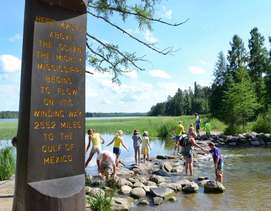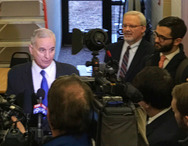|
February 2017
The Basin
Alliance for the Lower Mississippi in Minnesota (BALMM) will meet
Wednesday, Feb. 15, from 9 a.m. to noon at the People’s Energy Cooperative, 1775 Lake Shady
Ave. South in Oronoco, Minn.
Agenda
as follows:
- 9 a.m.: Nitrogen Management and Loss in Southeast Minnesota - Greg
Klinger, U
of M Extension
- 10:15 a.m.: Break
- 10:45 a.m.: Upper Mississippi River: What to protect, what to fix - Cathy Rofshus, public information officer, MPCA
- 11:15
a.m. – Updates on One Watershed, One Plan updates; ideas; and other
sharing – BALMM members
-
Noon: Adjourn
Greg
Klinger, University of Minnesota Extension educator in ag water quality
protection, will speak on Nitrogen Management and Loss in Southeast Minnesota
at the Feb. 15 BALMM meeting in Oronoco. Shallow soils and fractured bedrock
make southeast Minnesota particularly susceptible to groundwater contamination
with nitrate. The University of Minnesota has an increasingly good
understanding on how land management practices can negatively or positively
affect the movement of nitrate to groundwater. Klinger will discuss how
the 4R practices – rate, timing, form, placement – of nitrogen management
affect nitrogen loss in southeast Minnesota, and why nitrogen rate
recommendations are made the way that they are in Minnesota.
- Upcoming event on nitrogen management: Feb. 16 - Nitrogen Conference, Verizon Wireless Center,
Mankato.

The upper
Mississippi River, which starts at Lake Itasca in northern Minnesota, is in
great shape until pollutants flow in from farmland and cities. By the time it
reaches Minneapolis, it no longer meets water quality standards for river life
and recreation. Results from a new study by the Minnesota Pollution Control Agency
(MPCA) highlight the need to protect wetlands and forests in the iconic river’s
northern areas while taking action to curb pollution in its southern reaches.
The river is nearly pristine as it flows through forests, wetlands and lakes
until the land changes to cropland and cities. South of St. Cloud, pollutants
start to pour in with runoff, drainage and tributaries. These pollutants
include sediment that clouds the water; nutrients that cause algal blooms; and
bacteria that can make the water unsafe for swimming.
The study shows the northern reaches of the upper Mississippi are healthy,
thanks to the forests, wetlands and lakes that hold and filter the water
flowing to the river.
While the upper reaches need protection to keep the river healthy, the lower
reaches need large-scale changes to reduce pollutants. After the Crow River
flows into the Mississippi, phosphorus and nitrate pollution double in levels.
The Crow drains a heavily farmed area and makes up about 15% of the total land
area draining to the upper Mississippi in Minnesota.
The study also highlights the need to protect the upper Mississippi as a
source of drinking water. Nitrate can make water unsafe for drinking. While
levels are currently well below the threat level, water monitoring shows a
trend of increasing nitrate levels, a concern for the 1.2 million Minnesotans
who depend on the upper Mississippi for drinking water, as well as millions
farther downstream.
It’s important to continue efforts to decrease mercury levels in Minnesota
waters. Mercury levels in fish and in the water in the entire upper Mississippi
violate the consumption standard. This means guidelines will remain in place on
how much and what size of fish to eat.
Many projects are underway at the state and local levels to ensure that the
Upper Mississippi meets the standards for river life, recreation and fish
consumption.
At the Feb. 15 BALMM meeting, Cathy Rofshus, MPCA public information officer
and member of the Upper Mississippi
study communications team, will highlight the monitoring and assessment
results, along with the agency’s new approach to communicating about
high-profile studies.
|
 At the Environmental Congress Feb. 3 Gov. Mark Dayton announced a new “25 by ‘25” water quality goal, to improve Minnesota’s
water quality 25% by 2025. Without additional action, the quality of
Minnesota’s waters is expected to improve only 6 to 8% by 2034. If
approved by the Legislature, Gov. Dayton’s proposed new goal would engage
local governments, farmers, scientists, environmental groups, and business
leaders in a collaborative effort to address Minnesota’s water quality
challenges. News release.
Gov. Dayton has declared a “Year of Water Action” urging all Minnesotans
to rethink water usage in daily life, make informed consumer choices, and talk
to others about clean water protection and preservation. Last week, Gov. Dayton convened a Town Hall Water Summit
in Morris
to discuss water challenges and solutions in Greater Minnesota. More
information about all of Gov. Dayton’s proposed investments in clean,
affordable water can be found
here. Photo: MPCA
Commissioner John Linc Stine (second from right) looks on as Gov. Dayton
talks with reporters at the Environmental Congress.
|
 The Legislative-Citizen Commission on Minnesota Resources
is accepting proposals through May 15 for grants from the Environment and
Natural Resources Trust Fund, which is funded with Minnesota Lottery and
investment proceeds. The commission expects that $50 million will be available
for projects that start in July 2018.
Funding priorities for 2018 include:
- Foundational natural resource data and
information;
- Water resources;
- Environmental education;
- Aquatic and terrestrial invasive species;
- Air quality, climate change, and renewable
energy;
- Methods to protect or restore land, water, and
habitat and
- Land acquisition for habitat and recreation.
The commission is responsible for making funding recommendations
to the Minnesota Legislature. The full Request for Proposals is available on the commission’s
website. Since 1991, the fund has provided about $500 million
to 1,000 projects around the state.
|
 Gov. Mark Dayton recently signed an
agreement with the U.S. Department of Agriculture (USDA), securing $350 million
in federal funding to protect and improve waters in 60,000 acres across 54
Minnesota counties. The new state-federal effort, the Minnesota Conservation
Reserve Enhancement Program (CREP), will target areas of southern and western
Minnesota facing significant water quality challenges, to protect and improve natural
resources for future generations.
“Minnesota
is at a critical juncture in addressing our state’s serious water quality
challenges,” said Dayton. “Through this landmark agreement, Minnesota will be
better able to protect and improve our waters for our families, natural
habitat, and our future. Clean water is everyone’s challenge, and everyone’s
responsibility.”
Through the Minnesota CREP, farmers
and agricultural landowners can voluntarily enroll land in the Conservation
Reserve Program (CRP) and Reinvest in Minnesota (RIM) Reserve easement program
to create buffers, restore wetlands, and protect wellheads for drinking water.
Farmers and other landowners who voluntarily participate in the program will be
eligible for $350 million in federal funds for direct payments to farmers.
The Minnesota CREP will invest a total of $500 million
in Greater Minnesota. To leverage the full $350 million in federal funds, the
state of Minnesota must commit $150 million, of which $54.8 million has already
been appropriated in past legislative sessions. The rest is proposed in the
governor’s 2017 Jobs Bill and through the Clean Water Fund, Legislative-Citizens
Commission on Minnesota Resources, and Lesssard-Sams Outdoor Heritage
Council.
|
The MPCA recently submitted
Minnesota’s 2016 proposed Impaired Waters List to the U.S.
Environmental Protection Agency (EPA) for approval.
The MPCA posted a draft version
of the list for public viewing in July 2016. After a series of public meetings
and a formal comment period, the agency made a few changes to the draft list
based on public input. These changes consisted of removing three impairments
from the list and adding six. This modified list was submitted to the EPA for
its approval. This process of posting, revising, and submitting the Impaired
Waters List occurs every two years, as required by the federal Clean Water Act.
Contents of the public
meetings, the public comments, the MPCA responses to comments, and the updated
Guidance Manual were all sent to EPA along with the 2016 proposed list for
review.
Balancing
the economic and environmental benefits of soil management strategies
can be a challenge. U of M Extension Crops team has launched a website
that offers research-based resources to help producers improve soil and
crop productivity, while minimizing environmental risks. The website, Soil management and health, features articles and videos in three primary sections:
- Soil
properties – includes descriptions of Minnesota soils and how they are
formed, the importance of soil structure and the roles of organic matter
and soil biology in building structure.
- Tillage and
soil management – includes resources for reducing soil compaction and
erosion, managing crop residue, and evaluating tillage systems.
- Cover crops –
includes discussions on the benefits of cover crops and resources for
selecting, establishing and maintaining them.
- Soil fertility - provides a direct link to the U of M Extension Nutrient management website, which houses current crop fertilizer suggestions and data from the University of Minnesota.
The
website also includes presentations, an A to Z library to find topics
more easily, and links to other University soil websites.
|